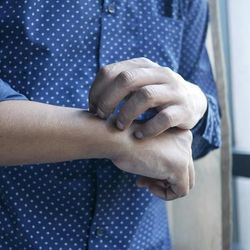
OR WAIT null SECS
Study Highlights Patient-Reported Disease Burdens in Children with Atopic Dermatitis
These data point to the necessity of incorporating disease burden in patient interactions and decision making for those under the age of 18 years.
Adolescent patients with atopic dermatitis are more likely to describe having a higher quality of life (QoL) burden because of their disease, new findings suggest, whereas pediatric patients are more likely to describe the most bothersome aspect as sleep disruption compared to adolescents.1
The investigators who identified these findings had set out to assess pediatric and adolescent patients and look into patient-reported disease burdens. The study was authored in part by Lawrence Eichenfield, MD, chief of pediatric and adolescent dermatology at Rady Children's Hospital-San Diego and professor of dermatology and pediatrics at the UC San Diego School of Medicine.
Eichenfield et al. highlighted that concerns related to treatment safety among children can result in atopic dermatitis being managed in a suboptimal manner.2
“This study investigated the disease burden of [atopic dermatitis], as reported by the patient or their caregiver, to identify specific needs associated with different age groups, thus highlighting opportunities for treatment interventions given the emerging treatment landscape,” Eichenfield and colleagues wrote.1
The investigative team's analysis drew on data from the Adelphi Real World Pediatric and Adolescent Atopic Dermatitis Disease Specific Programme (DSP). The DSP had been a cross-sectional study that involved the incorporation of retrospective chart reviews from clinicians treating pediatric and adolescent patients living with atopic dermatitis in routine clinical practice.
The DSP dataset was designed to collect different insights on patient disease burden, current treatment approaches, and outcomes to different therapeutics It was conducted between February - June 2019, with the analysis spanning across 6 countries: the United Kingdom, the US, France, Italy, Germany, and Spain.
Eligible participants included primary care physicians, pediatricians, dermatologists, and allergists who actively managed individuals under the age of 18 years with atopic dermatitis. Clinicians were compensated for their participation, and their recruitment involved a broad geographic range and local field agents.
Study subjects would be qualified for inclusion in the analysis provided they were under the age of 18, were not participating in a clinical study at the time of the analysis, and had a confirmed disease diagnosis. This analysis focused specifically on those identified by their doctor as having moderate-to-severe disease.
Information on clinical presentation, demographics, and participants' history of disease treatments. Patients and/or caregivers themselves were asked to report on the impact of their atopic dermatitis, touching on burden of symptoms and quality of life data.
There were 772 participants with moderate to severe atopic dermatitis who ended up being evaluated by the Eichenfield et al., including a total of 393 children aged 0–11 years and 379 adolescents in the age range of 12–17 years. Adolescents were found to be significantly more likely to be treated with systemic therapies, compared to younger children. Specifically, 24% of adolescents were provided with systemic corticosteroids versus 12% of children, 15% with phototherapy versus 6%, 15% with systemic immunosuppressants versus 6%, and 5% with biologic drugs versus 1% (P < .0001 for all comparisons).
Adolescents were noted by the investigative team as more likely than children to describe having anxiety-related distress. Specifically, 67% of adolescents versus 49% (P < .0001). Two-thirds of all subjects were found by investigators to report a high level of distress experiences due to pruritus, with 38% pointing to itch as the most troubling symptom.
Adolescents also reported significantly more problems related to self-consciousness or embarassment (P < .0001). Additionally, this age cohort also described more frequent social effects on their friendships as a result of living with atopic dermatitis (P < .05).
Overall, the investigators' findings point to key distinctions in disease burden between pediatric and adolescent subjects with atopic dermatitis. Such differences, Eichenfield and colleagues note, underscore the value of developing age-specific strategies for disease management.
“This highlights the need to incorporate disease burden in patient encounters and decision making for patients aged < 18 years and consider the potential value of improved treatment options for both pediatric and adolescent patients with moderate-to-severe [atopic dermatitis], given the evolving treatment landscape,” the investigators concluded.1
References
Eichenfield LF, Shi VY, Paller AS, et al. Patient-Reported Impact of Atopic Dermatitis on Pediatric and Adolescent Patients With Moderate-To-Severe Disease: Results of a Real-World, Cross-Sectional Survey. Pediatric Dermatology. https://doi.org/10.1111/pde.15940.
C Ellis, T Luger, D Abeck, et al. “International Consensus Conference on Atopic Dermatitis II (ICCAD II): Clinical Update and Current Treatment Strategies,” British Journal of Dermatology 148 Suppl 63, no. 63 (2003): 3–10, https://doi.org/10.1046/j.1365-2133.148.s63.1.x.
Related Content:


